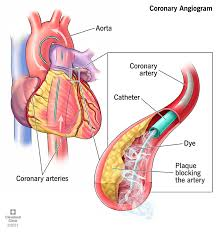A client is scheduled for a coronary angiography. In reviewing the client's record, what significant finding should the nurse report to the healthcare provider prior to this procedure?
A history of allergy to iodine.
Serum potassium level of 4.0 mEq/L.
Blood pressure reading of 138/90 mmHg.
An EKG that shows atrial fibrillation.
The Correct Answer is A
Choice a reason:
A history of allergy to iodine is a critical finding to report before a coronary angiography because the contrast dye used in the procedure typically contains iodine. Patients with an iodine allergy may experience severe reactions, including anaphylaxis, which can be life-threatening. Precautions such as premedication with steroids and antihistamines or the use of alternative contrast agents may be necessary.
Choice b reason:
A serum potassium level of 4.0 mEq/L is within the normal range, which is approximately 3.5 to 5.2 mEq/L for adults. Therefore, this finding is not significant and does not need to be reported to the healthcare provider prior to the procedure.
Choice c reason:
A blood pressure reading of 138/90 mmHg is slightly elevated but does not reach the threshold for stage 1 hypertension, which starts at 140/90 mmHg for individuals under 60 years of age. While it should be monitored, it is not an urgent concern that needs to be reported immediately before a coronary angiography unless the patient shows symptoms of hypertensive crisis.
Choice d reason:
An EKG showing atrial fibrillation is an important finding; however, it is not typically a contraindication for coronary angiography unless the patient is hemodynamically unstable or symptomatic. Atrial fibrillation can increase the risk of stroke, but anticoagulation management is usually the focus rather than postponing necessary diagnostic procedures.

Nursing Test Bank
Naxlex Comprehensive Predictor Exams
Related Questions
Correct Answer is A
Explanation
Choice A Reason:
A positive pregnancy test is crucial information that must be reported immediately as it has significant implications for the patient's health and treatment options. Pregnancy can impact the results of a Schilling's test, which is used to diagnose B12 deficiency anemia, as pregnancy itself can cause changes in B12 metabolism. Therefore, the healthcare provider must be informed to adjust the diagnostic approach and ensure the safety of both the mother and the developing fetus.
Choice B Reason:
While a hemoglobin level of 9.5 g/dL is below the normal range for adult females (11.6 to 15 g/dL) and a hematocrit of 32% is at the lower end of the normal range (36% to 44%)[^10^], these results are consistent with anemia but are not as immediately critical as a positive pregnancy test in the context of a Schilling's test.
Choice C Reason:
A glycosylated hemoglobin (A1c) level of 7.5% is above the normal range (4% to 5.9%), indicating poor blood sugar control over the past two to three months, which could suggest diabetes or prediabetes. However, this is not as urgent as a positive pregnancy test when considering the administration of a Schilling's test.
Choice D Reason:
A serum cholesterol level of 237 mg/dL is considered borderline high (200 to 239 mg/dL), which may increase the risk of heart disease over time. However, this does not require immediate reporting in the context of a Schilling's test for B12 deficiency anemia as compared to a positive pregnancy test.
Correct Answer is B
Explanation
Choice A reason:
Reviewing the diet and exercise guidelines with the client is an important step, but it may not address the immediate issue of the weight loss plateau. It's essential to first understand if the client has adhered to the guidelines before reviewing them.
Choice B reason:
Asking the client about any changes in diet or exercise patterns is the first step in identifying potential causes for the weight loss plateau. Changes in lifestyle, stress levels, eating habits, or physical activity can all contribute to a halt in weight loss. Understanding these factors can help the nurse tailor further advice and support.
Choice C reason:
Recommending a further reduction in calorie intake might not be the best initial approach. It's important to ensure that the client is not already consuming too few calories, which can slow metabolism and hinder weight loss. Moreover, drastic calorie reduction can be unsustainable and lead to nutritional deficiencies.
Choice D reason:
Instructing the client to record weights weekly is a useful tool for monitoring progress, but it does not address the current issue of the weight loss plateau. It's a supportive action that should follow after understanding and addressing the reasons behind the plateau.
Whether you are a student looking to ace your exams or a practicing nurse seeking to enhance your expertise , our nursing education contents will empower you with the confidence and competence to make a difference in the lives of patients and become a respected leader in the healthcare field.
Visit Naxlex, invest in your future and unlock endless possibilities with our unparalleled nursing education contents today
Report Wrong Answer on the Current Question
Do you disagree with the answer? If yes, what is your expected answer? Explain.
Kindly be descriptive with the issue you are facing.
